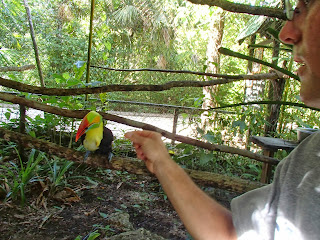This weekend we left Ambergris Caye for a trip to the
Belize Zoo. We've been on the island for five weeks now, and with the exception of a day trip to St. George's Caye, haven't left the island, so we were all looking forward to exploring a bit. We rode our bikes to the water taxi, got off in Belize City, took a taxi to the bus terminal, then rode a 'chicken bus' to the entrance of the Belize Zoo. All of the buses in Belize are re-purposed school buses from the States. Most of them are brightly painted and have unique names. There are no ticket counters at the bus terminal, no schedules, no website, and definitely no smart phone app. You just wait for your bus to show up (you know it's your bus because the hand-lettered sign in the windshield indicates the destination), you get on the bus, and then you pay the driver or the driver's assistant. Neither the drivers nor the helpers wear uniforms. There is no air conditioning, no bathroom, no television, no wifi--no amenities of any sort. However, it cost us US $1.50 a person to travel the 30 miles from the City to the Zoo.
 |
| On the water taxi to Belize City |
 |
| Bus time |
 |
| Our bus, just after dropping us off |
We arranged to stay in one of the guest houses at the Tropical Education Center, and we were picked up by one of their managers, brought to the 'Pond House' and dropped off our things. He drove us back to the zoo, and we purchased an annual membership and toured the zoo. It was amazing! All of the animals in the zoo are indigenous to Belize and were either born in the zoo, rescued from the wild and rehabilitated at the zoo, or donated to the zoo by people who realized their 'pets' were actually wild animals that they could not control. The facility itself is very impressive--it is a world-class zoo, well signed, with great exhibits and fascinating animals. We paid an extra US $10 to have a Toucan encounter and a Tapir encounter (the national animal and bird of Belize). We were able to enter the animals' enclosures with a zoo keeper and feed them. Those were both really amazing experiences.
After seeing all of the animals, we went back to the TEC, relaxed in the Pond House, then had dinner at the main building. We then got another ride back to the zoo for the nocturnal tour. We were the only people on the tour and had the entire place to ourselves! Our guide took us to all of the nocturnal animals' enclosures and we were able to feed them treats and view them up close. The highlight of the nighttime visit was getting to pet a jaguar's paws! That really made an impression on the boys.
The next morning we hiked around the TEC, did some birding, had breakfast and attempted to catch a bus after settling our bill at the Zoo. Unfortunately, the bus blew right by us. Apparently on Sundays, they are much less likely to pick people up outside of the designated station stops, and they only run every hour instead of every 1/2 hour. Fortunately, not more than three minutes after missing the bus, Brendalee--the same taxi driver that took us from the water taxi to the bus terminal the day before--pulled off the highway and beckoned us into her cab. She gave us a ride into town (which is a blog post in itself) and we made it on to the water taxi just before its scheduled departure.
It was a fun and surprisingly smooth trip. We will be taking more trips to the mainland over the coming months, and it is encouraging to discover that it is fairly easy.



















No comments:
Post a Comment